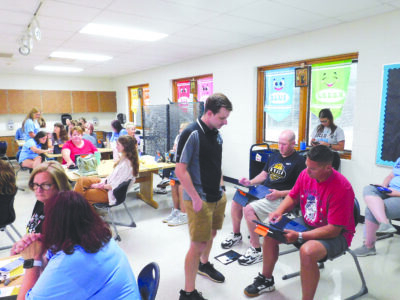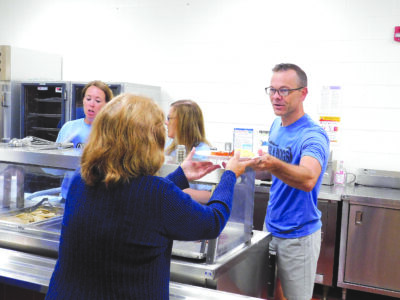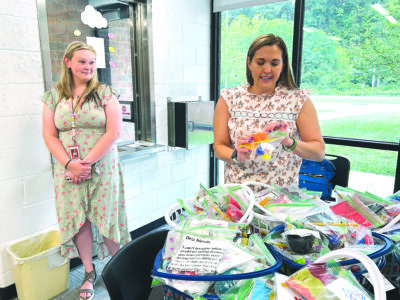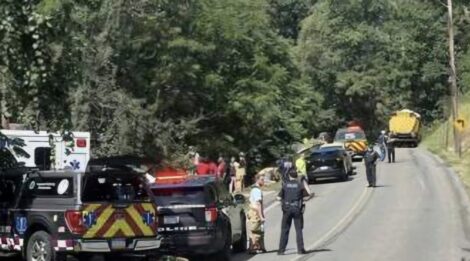Long-term recovery team helps flood victims rebuild what was lost
The Emergency Flood Response Team, established after the June 14 flash flooding in the valley, has transitioned into a Long-Term Recovery Team to assist flood victims in rebuilding their lives, from finding housing to purchasing new kitchen appliances.
More than 30 local agencies comprise the team, headed by United Way of the Upper Ohio Valley Community Resource Specialist and Data Coordinator Melynda Sampson. Ohio County Family Resource Network Executive Director Claudia Raymer headed the Emergency Flood Response Team.
The focus of the group will be to assist flood victims in long-term recovery, as other agencies that helped with short-term flood cleanup, such as Samaritan’s Purse, begin to leave the valley.
“In the past, long-term recovery committees have stayed in place until the very last person is stable, then we deconstruct after that,” Sampson said. “That could take months or a year or more, depending on how long it takes each person to become stable.”
Sampson encourages any flood victims to contact the United Way of the Upper Ohio Valley at 304-232-4625, ext. 1, for flood assistance. Victims can also reach the United Way by dialing 211 and then entering their zip code.
The United Way will serve as the entry point for people in need of long-term flood assistance. When they reach out to the agency, Sampson and other case managers will direct them to the help they need from local agencies.
Long-Term Recovery Team member Susan Hagan, who serves as the Coordinator for the Northern Panhandle Continuum of Care, emphasized that flood victims do not need to “max out everything” before they seek assistance. She noted that a single phone call to United Way can connect them with the Long-Term Recovery Team to get the assistance they need.
“I think it’s important for us to try to get the word out there because we know there are still people that need help that don’t know where to go,” Hagan said. “People are paying for their own hotel rooms that didn’t know they could get help, and they’re maxing out everything they have when there is help available to them.”
One of the first steps the team is taking to facilitate long-term recovery in the valley is organizing people who have been made homeless due to the flooding into short-term, long-term and permanent housing lists. Short-term can repair their homes quickly and move back in, long-term can possibly move back in after six months or longer and permanent cannot move back in and cannot rebuild where they lived.
According to Ohio County Emergency Management Agency Director Lou Vargo, 34 houses were deemed uninhabitable due to the flooding. This number may grow after the substantial damage team with the West Virginia EMA reviews the impacted houses in the area.
Hagan said that the number of people displaced due to the flooding exceeds the 34 houses deemed uninhabitable. Families and more than one person lived in a number of these residences.
The Long-Term Recovery team has been asking people to sign up on the Counting Us mobile app to add to the list of those displaced. If they are unable to sign up on the app, they can contact Sampson for assistance. Other flood victims have also registered with the National Voluntary Organizations Active in Disaster.
Flood victim families have been assigned to case managers provided by local agencies to assist them. Sampson and Hagan are also working with local agencies to connect those whose names are on the list of people made homeless by the flooding with housing assistance.
“We’re comparing all of those lists together to try to make sure that we don’t miss anyone, and then we are slowly starting to work on that list,” Hagan said. “It’s a slow process. Unfortunately, I think everybody wants to be taken care of as quickly as possible, and we do too, but housing being what it is, takes time.”
Financial assistance is available for those made homeless, including the West Virginia Housing Development Fund’s Emergency Rental Assistance Portal. The program, which began after the COVID-19 pandemic, will help residents pay their deposit and rent through Sept. 30. An additional $500,000 in assistance is also available to flood victims through the WVHDF.
Other housing assistance programs include the Catholic Charities Rapid Rehousing program, which is funded through HUD. The Great Wheeling Homeless Coalition offers Youth Rapid Rehousing to individuals aged 18-24.
Another housing resource is the Northern Panhandle HOME Consortium First Time Homebuyer Program, which Hagan said flood victims may qualify for and receive benefits from.
In addition to housing assistance, Hagan noted other local agencies have funding to provide for other aspects of disaster relief. This includes money available to pay for home appliances, water tanks, washers, dryers, HVAC systems, toilets, sinks, bathtubs and showers.
Sampson said a new type of donation that will be needed in the long term is building materials, including carpeting, flooring, drywall and screws.
“People will need the necessities to make life livable again in the long term,” Hagan said. “People lost every single necessity, including bedding and food, so they need it replaced.”
Hagan said an important aspect of the Long-Term Recovery Team was making clear pathways for flood victims to receive assistance from “all the money that came in very quickly” to the valley following the flooding.
“There’s a lot of sorting out of who’s doing what right now,” Hagan said. “Ohio Valley Mutual Aid, Ohio Valley EMA, the Community Foundation, Catholic Charities, the Soup Kitchen and the WV HDF all have money, so we’re sorting through all of that. It’s trying to decide what is the best place for each person to get served.”
The Long-Term Recovery Team is also keeping volunteers in mind who want to assist in flood relief. A platform to coordinate volunteers is in the works. This sign-up website would allow volunteers to choose when and for how long they want to volunteer, and then direct them to the organization or location where they can volunteer during that time.
Hagan said another type of volunteer that will soon be needed is case managers for flood victims. She said any current or former social workers could assist with this, while those with no experience in the field must undergo training with Catholic Charities.
“Catholic Charities has a long-term disaster team, and when they hit the ground in an area and recommend somebody for help, that case has to go through a Disaster Case Manager,” Hagan said. “Catholic Charities does not have a lot of those, so anybody who wants that job, Catholic Charities is going to have money to train people in that.”
Hagan emphasized that volunteers must pace themselves during the long-term recovery process. She added that donations and volunteering will still be needed two to three weeks from now.
“A lot of people hit the ground running the moment after the flooding, I thought, ‘Man, we’re going to need some of these people in a few weeks,'” Hagan said. “I know some restaurants that are even like, ‘Listen, I’m not going to send anything right now because I sent stuff in the beginning. I’m going to slow down now and then let me know what you need in three weeks.'”
As agencies and volunteers transition from short-term to long-term flood relief efforts, Hagan noted that “nothing would go to waste” when it comes to donations or assistance. She was impressed by the community response “day one” and said “nothing would go by the wayside.
“At one point, there was so much stuff being donated that we didn’t have anywhere to put it,” Hagan said. “We have enough water to feed the entire state of West Virginia for a year, but that’s a good thing because all of that stuff is needed and will be used in the long term. Everything is being used, and the businesses and people that have stepped up to help have made a huge impact.”




